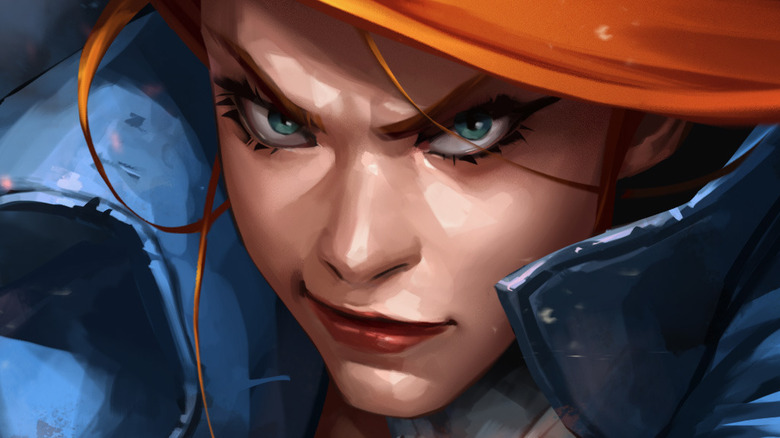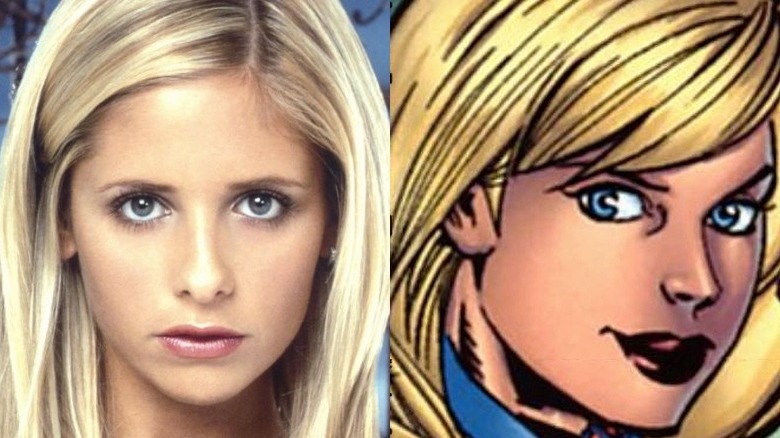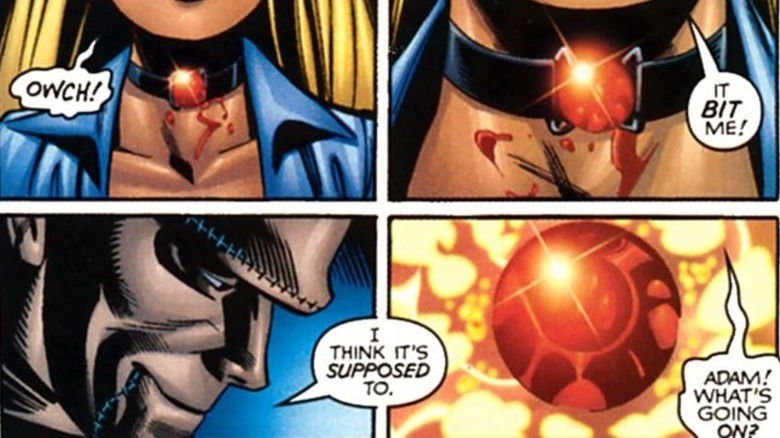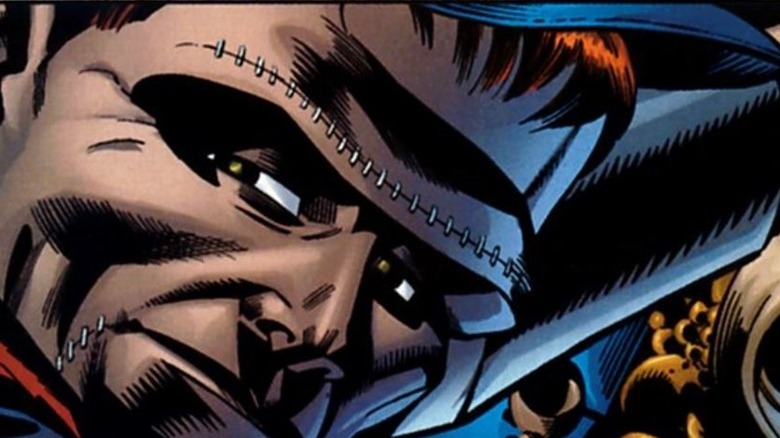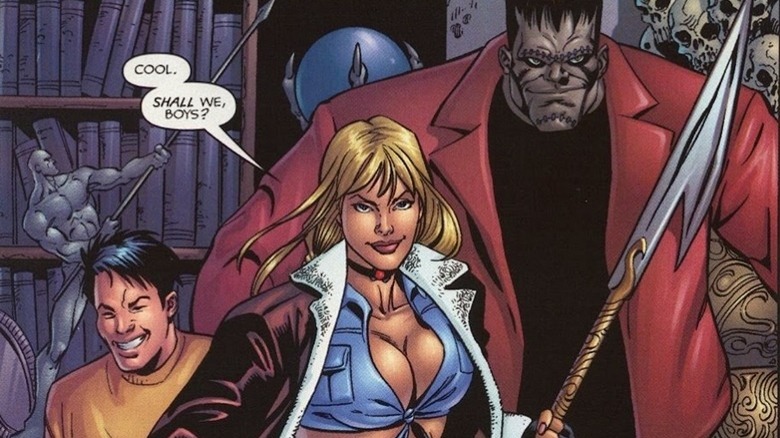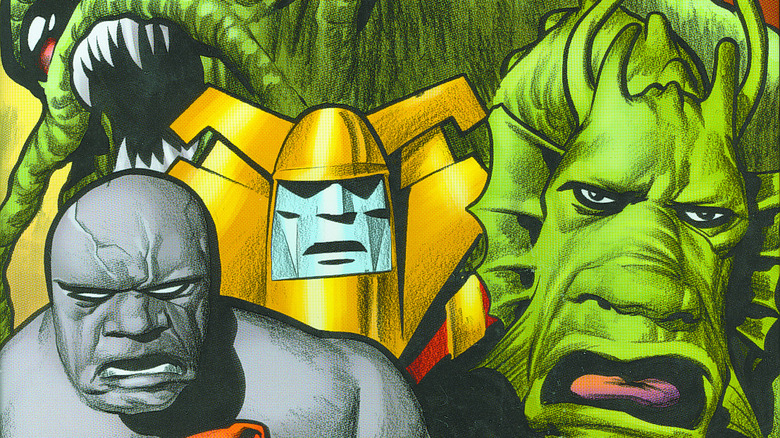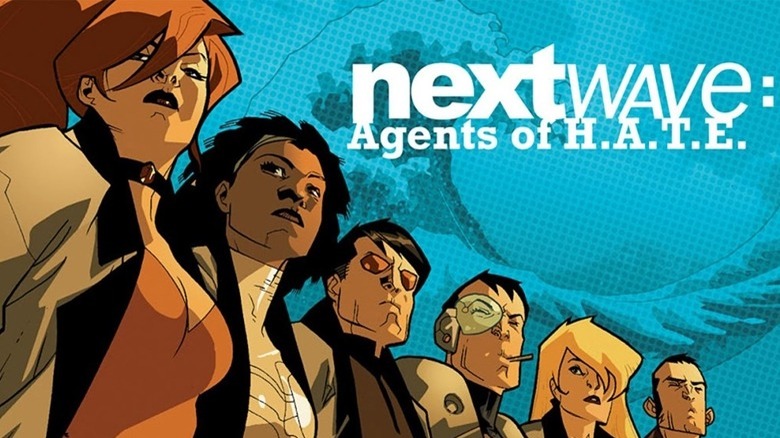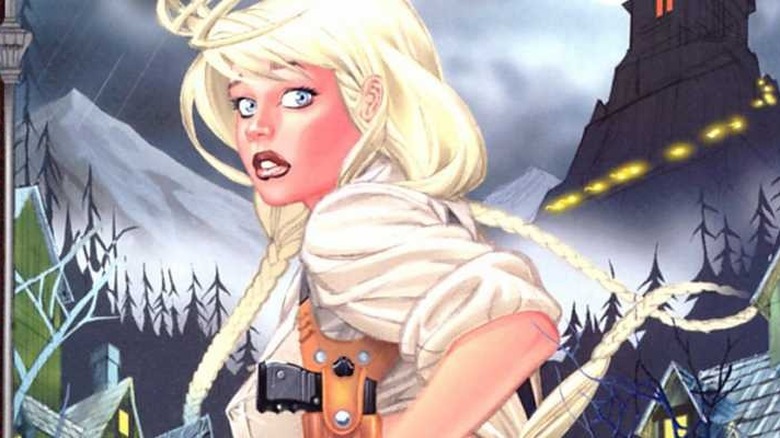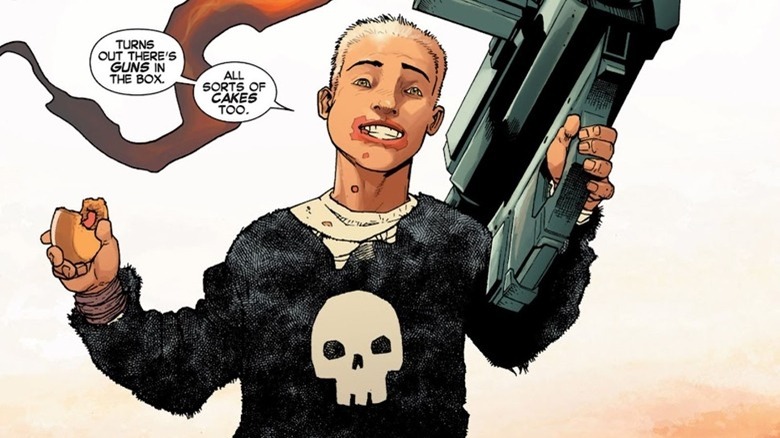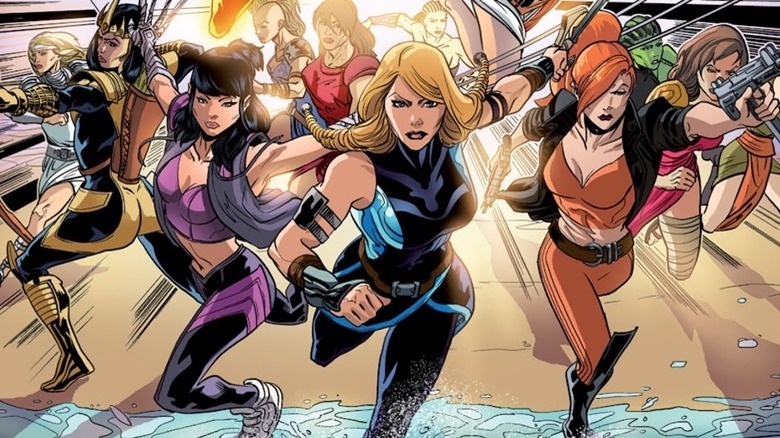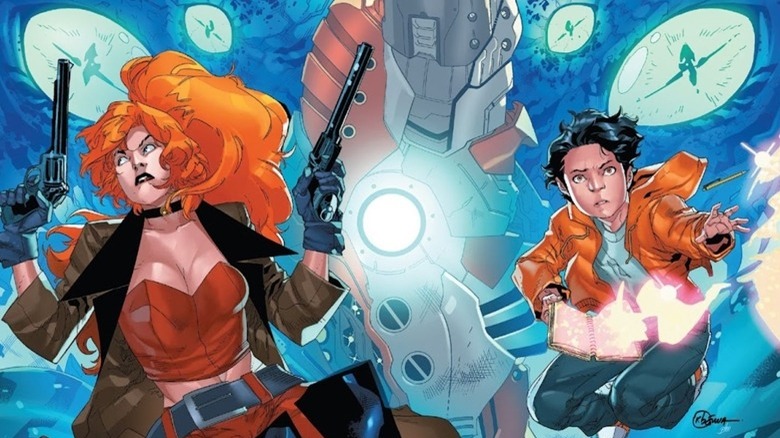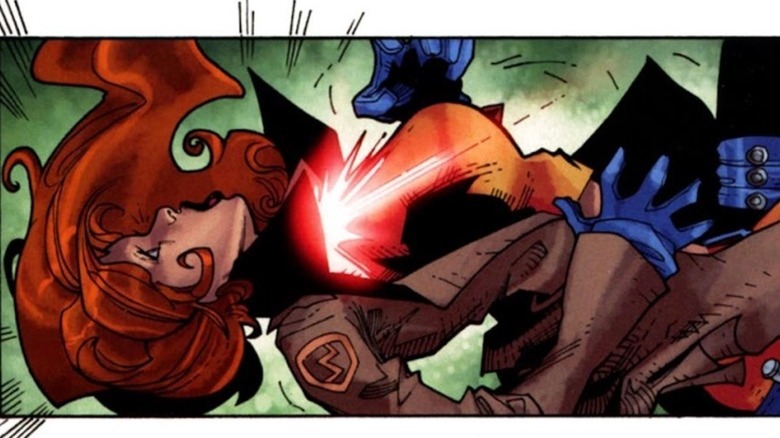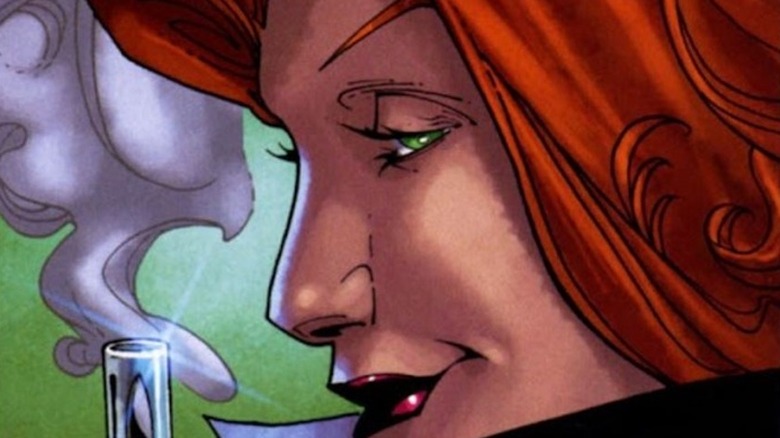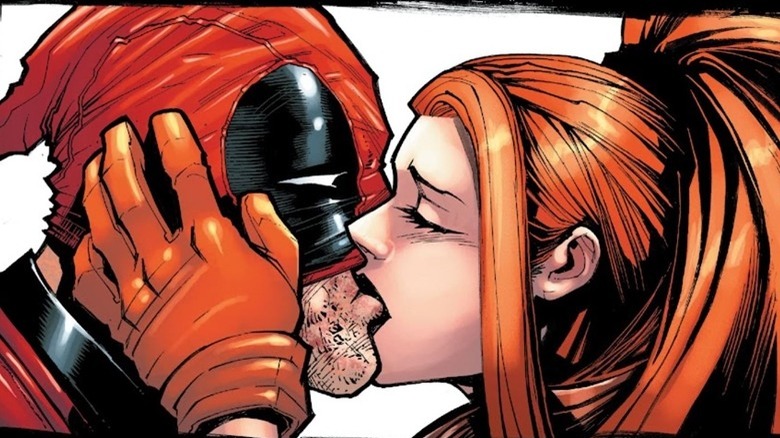The Untold Truth Of Elsa Bloodstone
Imagine growing up the daughter of a nigh immortal monster hunter who isn't big on emotional availability or being physically present. And on the rare occasion when he can be bothered to be around, he's constantly forcing you to endure tests to toughen you up to follow in his footsteps. Such was childhood for Elsa Bloodstone, daughter of Ulysses Bloodstone.
First appearing in 2001's "Bloodstone," Elsa went on to become a cult favorite on the pages of Marvel Comics. She's now taking that popularity to the small screen, making her MCU debut in "Werewolf by Night."
Her popularity is a bit of a surprise, given where she started. The 2001 series is a cheesecake-y, tongue-in-cheek limited series from Dan Abnett, Andy Lanning, and Michael Lopez that audiences largely ignored. Five years later, however, she became the breakout star of arguably one of the funniest comic series of the 21st century, "Nextwave."
Since her debut, Elsa has worn many hats — and a few hair colors — on her way to becoming an unexpectedly delightful figure in the Marvel Universe. Her history, however, is strange and convoluted enough that even her biggest fans are likely to have missed a detail or two — or several — since she sprang onto the four-color scene on her way to becoming Marvel's pre-eminent monster hunter. So, to ensure you're every bit the expert you want to be, we here at Looper present you with the untold truth of Elsa Bloodstone.
Don't call me Buffy
Elsa Bloodstone began her comic book life as an attractive blonde teen. She had been the unwitting heir to a sacred duty involving monster killing; that destiny came with a set of superpowers including increased strength, speed, and resilience. Any of that sound at all familiar?
If you find yourself thinking of one Buffy Summers, the lead character of the mega-cult hit "Buffy the Vampire Slayer," you wouldn't be the first to make that connection. "Buffy," after all, arrived on TV screens four years before Elsa became a Marvel character. The characters featured a similar look and attitude at the time. Especially during the show's heyday, Buffy Summers was a wildly popular TV superhero and something of a pioneer for female protagonists in sci-fi-fantasy genre media. As far as sources for inspiration, Dan Abnett and Michael Lopez certainly could've done worse than Buffy.
Except they say that wasn't quite the case. When asked about the similarities, the writing team of Abnett and Andy Lanning didn't argue against their existence. However, they insisted, "[We] can honestly say that neither of us have seen an episode of 'Buffy' all the way through! I know we're missing out on some great TV, but we've determined to steer clear of Buffy at least while we're doing 'Bloodstone.'"
The team was aware of the vampire slayer, of course, but judiciously steered clear of knowing too much about her to prevent people from getting the idea that Elsa began as Marvel's Buffy. For all the good it did in that regard, Abnett and Lanning might as well have kept up with the weekly adventures of Buffy, Spike, and the rest of the Sunnydale gang with the rest of us. Live and learn, right?
Bloodstone isn't just a name
Elsa comes by her surname through her father, Ulysses Bloodstone, Marvel's first monster hunter to wear the Bloodstone name. However, it has more significance than just the standard process of a child inheriting a parent's name.
Readers will notice that Elsa always wears a chocker with a single red rock in its center. No matter how different she's looked over the years, the one constant of her appearance is that bit of jewelry. The rock in question is the "Bloodgem" or "Bloodstone." Over time, the gem becomes the source of the family's surname.
In addition to her last name, the object also gives Elsa the powers to do what she does. While she has some natural advantages, it is clear that once she first donned the choker and the stone "bit" her, her strength, speed, stamina, and resilience increased to peak human levels. However, it remains unclear if her love of guns and gift for marksmanship can also be owed to the Bloodgem.
Have you met my Frankenstein's Monster? Or my Genie?
When Ulysses finally dies after more than 10,000 years of walking the Earth, Elsa inherits the entirety of his possessions. This includes the Bloodgem that fuels her powers, his massive Massachusetts estate, and his lifelong commitment to monster stomping.
It also includes the support and guidance of Adam, a tall, broad-shouldered fellow who bears a striking resemblance to the classic interpretation of Frankenstein's Monster — head stitches included. A sort of combination of friend and valet to her father, Adam helps Elsa understand what she's been called to do and serves as her partner in her first few missions.
Elsa also discovers another supernatural being who assists her in her new mission, albeit significantly less voluntarily. A classic genie in a lamp enslaved by Ulysses thousands of years before, the being acts as Elsa's teleportation device, sending her anywhere she wishes and retrieves her when things start to look hairy. Unlike Adam, the genie never bothers to come out of the lamp or gets to know Elsa. One supposes that a thousand years of granting wishes fosters considerable disinterest in getting to know the new master.
Taking some me time
While the "Bloodstone" miniseries leaves Elsa and her support team about to run a raid on a certain pesky kraken, readers never see how that water-logged mission works out. In fact, readers went four years without seeing Elsa at all.
It seems that while she eventually found a loyal fanbase, Elsa didn't manage to grab much attention in her debut limited series. As a result, the heir to the Bloodstone monster-killing legacy disappeared from the pages of Marvel Comics. All indications are that she kept herself busy, but those adventures remain lost to time, at least for now. Given the nature of comics, though, who knows? Perhaps some creators will work their way back to those four "lost" years and chronicle the kinds of scrapes Elsa got into while readers were off following the ongoing adventures of the era's immediately popular new characters like Jessica Jones and X-23. And maybe we can all finally find out what happened with that darn sea monster.
Elsa Bloodstone — web 2.0 pioneer
When Elsa finally returns to the printed page, readers do get at least some insight into how she kept herself busy. It seems that in addition to chasing down chupacabras and slapping around sasquatches, Elsa decided to join the digital revolution.
To keep track of all the wild creatures, beasts, cryptids, and monsters she encounters, Elsa starts a Wikipedia-esque site where she shares the facts of all the beings she has tangled with, as well as her personal experiences with them. In addition to being an essential resource for herself, it pays her experiences forward. So, when Ma and Pa Smith begin finding massive footprints in their pastures and levitating cattle in their barns, they can hop on the internet and see if they were dealing with a moomba or an ulvar and how to solve whatever problems they cause.
A collection of selections from her online resource came in the form of "Marvel Monsters: From the Files of Ulysses Bloodstone and the Monster Hunters" in the mid-'00s. As a result, her return to Marvel Comics features lots of her voice but only a single headshot image of her.
The comics consensus finally catches up
After "Marvel Monsters," another year went by before Elsa Bloodstone made her in-person return to comic pages. But what a return it was.
"Nextwave," the series by Warren Ellis and Stuart Immonen, startled many readers in 2006. The team, a collection of has-beens and knockoffs, hardly seemed like the sort of book that would become the coolest comic from the Big Two for the next year. However, it quickly became just that.
Elsa joins Monica Rambeau — the second Captain Marvel, then going by the name Pulsar — the disgusted by humanity Machine Man, Boom-Boom, and Captain [censored for time and content] under the employ of Dirk Anger. To get a sense of Dirk Anger, think Nick Fury with fewer people skills and no rage management abilities. Dirk Anger leads H.A.T.E. — the Highest Anti-Terrorism Effort — an organization dedicated to the finding and eliminating Unusual Weapons of Mass Destruction.
Elsa's personality apparently developed an edge during her five years out of the spotlight, and readers quickly fell in love with her new foul-mouthed, zero capacity for nonsense approach to life. That sweet blonde teen from 2001's "Bloodstone" was entirely gone. In her place stood a take-no-prisoners expert on monsters who loves nothing more than mowing down opponents with twin Uzis and declaring her appreciation for the European Union.
A few continuity glitches
For continuity obsessives, "Nextwave" proved a bit of a headache. Certain differences, like Elsa's new mane of red hair, could be easily explained or overlooked. Hair dye is a thing, after all. For all fans know, she was a natural redhead going through a bleaching phase. Or heck, maybe she has chestnut-colored hair, but she likes messing around with different colors. Other changes, though, proved a bit stickier.
For instance, when fans first met Elsa, the "Bloodstone" limited series emphasized that she did not know her father at all. In "Nextwave," however, we witness countless instances of Ulysses training her for her future through a series of tests that could charitably earn the label "torturous."
Given the team's adventures clearly took place in alternate realities, one initial explanation was the team existed outside of mainstream Marvel continuity. Since "Nextwave" ended, however, Marvel has incorporated those versions of the characters into the 616 timeline, which suggests "Nextwave" Elsa is the Elsa from "Bloodstone."
However, the series makes it clear that H.A.T.E. drugs and otherwise attempts to mentally dominate the team members throughout the series. Thus, Elsa's memories of her brutal father may be simply false recollections induced by substances and mind control. Similarly, her memories may be accurate, but she had either forgotten them due to trauma or fatherly meddling. H.A.T.E.'s techniques accidentally retrieved them and forced her to reexperience her brutal past.
Not an only child
It turns out that when your dad lives the equivalent of 500 or more generations, the possibility that you might be an only child is quite small. Therefore, despite growing up with no awareness of any siblings, it turns out Elsa has at least one older half-sister and one younger half-brother. Given Ulysses' longevity, three children seems like a remarkably small number, so it's entirely likely that Elsa has other family out there.
Her older sister Lyra seems to have inherited their father's gift for longevity. At over a thousand years old, she still looks roughly the same age as Elsa. For unclear reasons, Ulysses sent her into space, a fact that puts Elsa understandably on guard. Still, to date, Lyra seems friendly, if a bit strange in a way that all Bloodstones must be.
Elsa's younger sibling Cullen's entire life was changed by the death of their father, just like his older sister. However, while Elsa got all of her father's possessions, Cullen was left stranded in the wilderness for more than two years. By the time he was finally discovered, he shared his body with a rampaging monster. However, thanks to a Bloodgem ring, Cullen can now control the beast within. Unfortunately, his life continues to be an exercise in trauma. Only a few months after returning to civilization, the X-Men villain Arcade kidnaps Cullen and forces him and other teen heroes to fight for survival on a Murder World island.
An unlikely joiner
While clearly a bit rough around the edges, Elsa has proven a surprisingly adept and in-demand team member. Her skills and willingness to put aside differences for the sake of the mission evidently outweigh her acidic tongue and often unpleasant attitude.
Her most unexpected team membership is definitely her time with an Avengers team led by Doctor Doom. When a global event "inverted" several heroes and villains— that is, it made the good guys bad and the bad guys good — Doom became a true-blue do-gooder. Elsa dodged inversion and ended up on the new Avengers squad, protecting Doom and Latveria from an inverted Scarlet Witch bent on bloody revenge.
Elsa also fought alongside the all-woman team of superheroes, the Fearless Defenders. The Defenders specifically recruited her to stamp out a monster problem in Chinatown. However, after getting that done, she elected to hang around a bit longer to help the team overcome Caroline Le Fay. Most recently, Elsa joined the Midnight Sons alongside the likes of Moon Knight and Doctor Voodoo for some supernatural throwdowns.
A member of the gig economy
Things are tough out there these days, even for women destined to be super-powered monster fighters due to a combination of genetics, upbringing, and a magic stone. So, while Elsa's passion may be found in tossing around Trogg and his ilk, she still needs to do other things to make ends meet.
As a result, like many of us, Elsa sports quite a diverse CV. When her brother Cullen begins attending the Braddock Academy, Elsa joins up as a member of the faculty. Although fans saw little of her teaching on the page, readers witnessed her riding a monster across campus before crashing it headfirst into headmaster Captain Britain's office. Perhaps education may not be the right field for her skills.
In "Avengers World" #15, Elsa hosts a television reality series about monster hunting, which seems a little more in her wheelhouse. Who better to host a show about that sort of thing than Marvel's most prominent expert, right? At present, little has ever been seen of the show, though. Perhaps her fondness for four-letter words made the whole thing a no-go even during this streaming-heavy, content-hungry era.
Her most successful side hustle also happens to be her most ironic. When an Inhuman prophecy identifies Kid Kaiju, a teenager with the ability to create monsters by drawing them, as destined to be a great hero, Elsa agrees to be his bodyguard, encouraging his monster creation for the good of all reality.
Well, I'll be a monster's mama
Back on full-time monster hunting, Elsa tracks down the so-called Children of Goram — offspring of a monster her father slayed several years earlier. Unfortunately, in the monsters' desperation to continue their bloodline, one of the creatures manages to bite Elsa. The Children reproduce by biting a host, so Elsa finds herself carrying the next generation of Goram monster. The Bloodgem, however, proves a kind of vaccine against the monster baby. It saves Elsa from either becoming the mother of another Goram or being destroyed by the process.
While Elsa had never shirked her responsibility to fight monsters, something about the experience seems to throw a trigger within her. She pledges not just to keep fighting them but to survive until she rids the Earth of all (presumably evil) monsters. While a seemingly insurmountable task, her genetics suggest she might have the ability to live long to see that goal realized. Her father didn't do it over tens of thousands of years, but maybe he made enough of a dent for her to finish the job.
The Bloodstone bloodline ends here
That ill-fated brush with motherhood inspired Elsa to make another pledge as well. Her generation of Bloodstones will be the last. No matter what happens with the monster fighting or where her life takes her from now on, she will never have a child.
There are a few reasons for this. First are the memories, whether real or not, of how her father treated her. If that's what it takes to raise a child in the Bloodstone business, Elsa wants no part of it.
However, even if it were possible for her to raise a child compassionately to take on the monster hunting trade, she wouldn't want to inflict that on someone else, especially her own child. Being a Bloodstone monster hunter is an unfair burden that seems invariably to involve trauma. Elsa refuses to perpetuate that cycle for another generation.
She wants love, just a different kind
Just because Elsa Bloodstone has decided to end her family's legacy doesn't mean she's opposed to finding love. Unfortunately, she isn't exactly pursuing uncomplicated affairs.
She has managed to dodge the usual monster hunter pitfall by not falling in love with one of the beasts she's sworn to destroy, so that's an undeniable point in her favor, and one thing she definitely does not have in common with Buffy Summers. That acknowledged, her romantic choices seem, well, a bit questionable — particularly Deadpool.
Initially, the relationship is all business. Deadpool needs help being king of the monsters (long story), and Elsa provides that kind of support. Deadpool keeping the monsters in line makes Elsa's life easier. That's especially timely news, as an encounter with a bone beast has infected her Bloodgem, slowly killing her. Deadpool assists her with that, eventually killing the bone beast queen and purifying her gem. The act is enough to get Elsa to confess their flirting hasn't just been fun but the result of actual romantic feelings.
Alas, it seems their differences must have proven too much as there hasn't been a whisper of their love in some time. Elsa leaving to check on her brother in England seems to have ended things. Perhaps it is true what they say — those relationships that burn brightest burn briefest.
